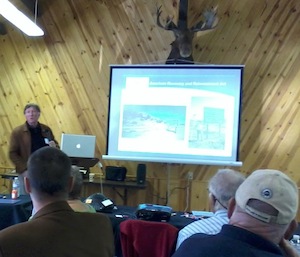
“We have started and we will finish,” said Michael Ort, CEO of Praxis Associates, the company behind the Digital 395 project. “There have been people who have bet against us and that’s a great motivator. It’s going to happen.”
The ambitious, ARRA-funded network will connect Reno to Barstow, in the California desert east of Los Angeles, installing nearly 600 miles of fiber optic cable. Most of the path runs along U.S. 395, down the eastern side of the Sierra Nevada through towns like Carson City, Mammoth Lakes, Bishop and Ridgecrest.
Ort was giving an update to a community broadband forum organized by the Eastern Sierra Connect Regional Broadband Consortium in the Mono County town of June Lake. The project has been enthusiastically backed by local officials and residents, who are eager to bring high capacity, carrier grade middle mile connectivity to the many small towns, communities and tribal lands along the way.
But even with that support, bureaucracy has been the biggest obstacle he’s had to overcome.
Problems have come from the maze of state and federal regulators that have a say. Twenty three different agencies had to sign off on project plans, a process that ate up two years of what is supposed to be a three year project.
“You have to satisfy everyone’s needs,” said Ort, explaining that different agencies have different objectives and sometimes exactly opposite requirements. For example, one might ban digging along a certain route while another might require it. Approvals included individual permits for almost 400 archeological and historic sites.
Even so, Ort is confident they’ll have it operating by the 31 July 2013 deadline.
The project is funded by $81 million from the 2009 federal stimulus bill, under the Broadband Technology Opportunities Program (BTOP), and $19 million from the California Advanced Services Fund. Ort says construction costs – not counting permits and environmental clearances – are running between $25 and $30 a foot. Much of the work involves plowing fiber into the ground, but some it requires using a giant “rock wheel” to chop through granite.
When it’s done, Digital 395 will dramatically reduce the cost of connecting to the Internet from eastern California. Customers will primarily be major institutional users, Internet service providers and other resellers, and major telecommunications companies that want a back-up path between northern and southern California. Plans are to price 100 Mbps of Internet connectivity in the one thousand dollar range, using traditional T-1 lines as both pricing and quality of service benchmarks. Simple Layer 2 – Ethernet – connectivity would be about $6 per Mbps, under current plans. Pricing would be flat and not dependent on distance.
